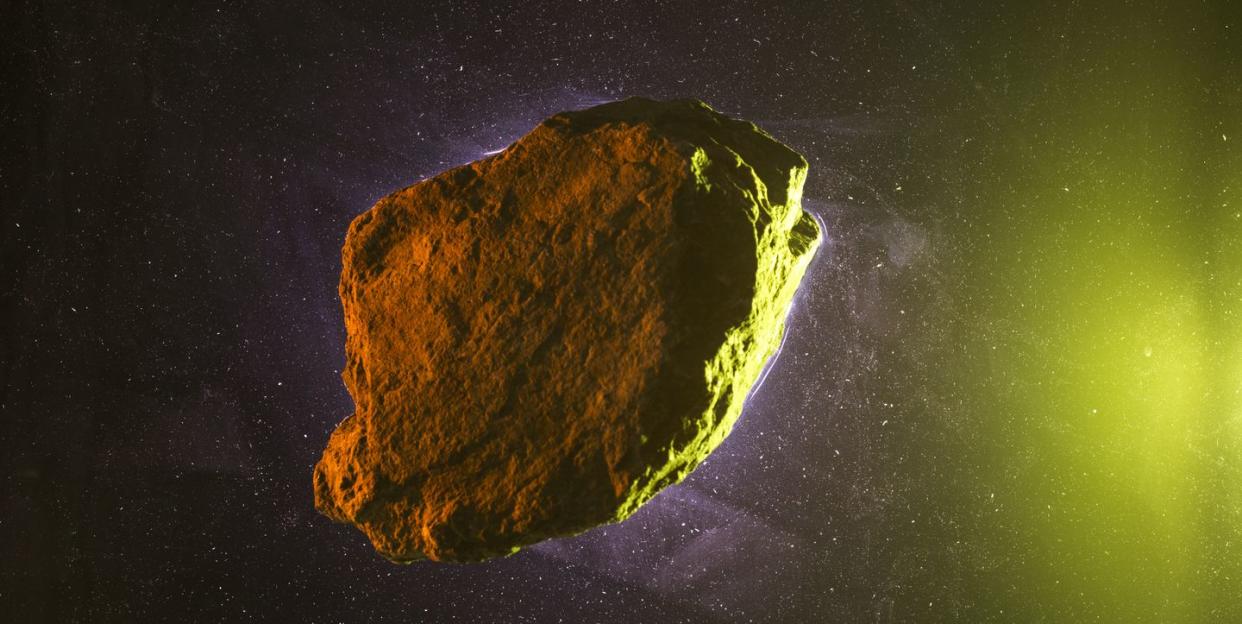Football stadium-sized asteroid will swing past earth today

"Hearst Magazines and Yahoo may earn commission or revenue on some items through the links below."
An asteroid the size of a football stadium will zip past Earth today.
The asteroid, 2022 BH7, is one of four near-Earth objects making a close approach this weekend. (Fear not. We are safe for now.)
The race to find potentially hazardous objects in our solar system could become more complicated as satellite megaconstellations expand.
A roughly 720-foot asteroid named 2022 BH7 is making a close pass by Earth on Friday, February 18. (Don’t worry, there’s literally no chance it’ll hit us.)
💫 You love the cosmos. So do we. Let’s nerd out over it together.
This asteroid is one of several swinging past Earth this week. In total, two others—both the size of a jet airliner—are scheduled to slip past Earth on February 18. And the school bus-sized object 2022 CX4 is scheduled to come within 677,000 miles of Earth—the closest approach of the bunch at roughly three times the distance from Earth to the moon—on February 19.
Scanning the skies for these objects is tricky business. A vast network of observatories both in orbit and on Earth are working fastidiously to catalogue and track near-Earth objects in our solar system. And NASA’s Planetary Defense Office (PDO) is coordinating with other organizations and institutions to develop a response to any potentially hazardous objects skulking around our cosmic neighborhood. As of right now, they haven’t identified any objects that pose an imminent threat.
But there’s still a lot of work to be done. While we’ve identified most of the large and medium-sized objects in our solar system (>1 km and >300 meters, respectively), we’ve spotted less than half of the “estimated 25,000 NEOs that are 140 meters (460 feet) in size and larger,” according to an estimate by the PDO. Objects of this size aren’t technically “planet-killers,” but they could still pack a punch.
Spotting these wayward space rocks could soon become even more difficult for researchers as the vast web of communications satellites continues to expand around our planet. In a five-page letter to the Federal Communications Commission earlier this month, for instance, NASA detailed its concerns that SpaceX’s planned constellation of 30,000 Starlink Gen-2 satellites could hamper the efforts of Earth-bound observatories to search for potentially hazardous objects.
“These telescopes occasionally find satellite streaks in their images that could interfere with or hide asteroid detections,” the agency wrote. “With the addition of ~30,000 Starlink satellites as described in the Gen2 amendment request, NASA estimates that there would be a Starlink in every single asteroid survey image taken for planetary defense against hazardous asteroid impacts, decreasing asteroid survey effectiveness by rendering portions of images unusable."
While NASA didn’t technically ask the FCC to reject SpaceX’s proposal, it is asking them to proceed with caution, given how many near-Earth objects there are lurking in the darkest corners of our solar system. Maybe that’s not such a bad idea when you consider all the tiny pieces of junk orbiting the Earth.
If you’re eager to keep an eye on our solar system’s asteroids, check out the Jet Propulsion Laboratory's Eyes on Asteroids web tool, which monitors near-Earth objects around the solar system. You can find your favorites—be it Bennu, Didymos, or Apophis—and explore their trajectories.
Be forewarned: You could come down with a case of the heebie-jeebies.
You Might Also Like
